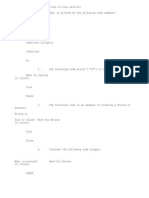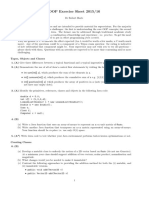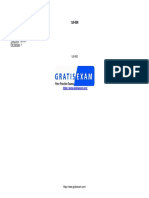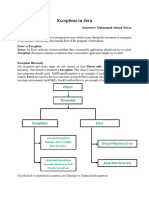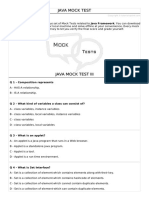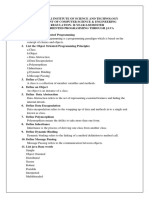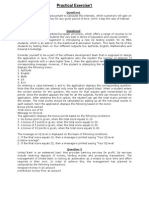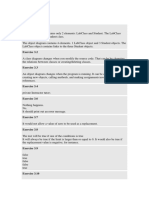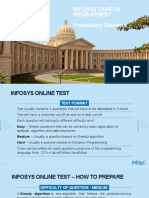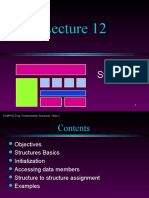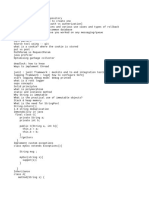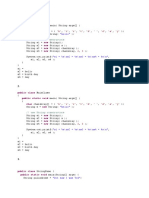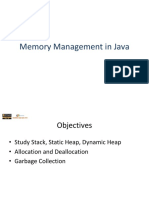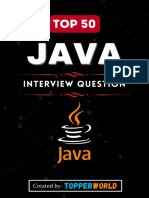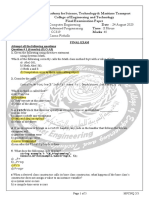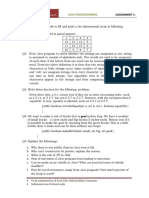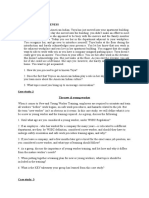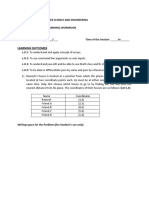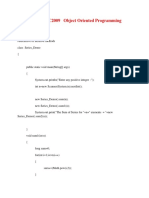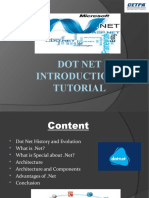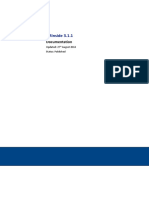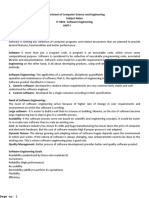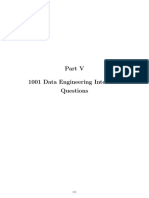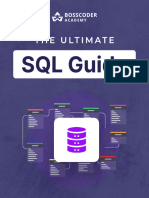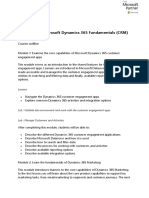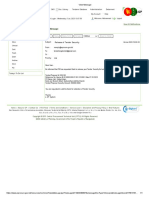Session-31 - Java Files and Streams
Uploaded by
priya uppalaSession-31 - Java Files and Streams
Uploaded by
priya uppala1
1
4
Files and Streams
2005 Pearson Education, Inc. All rights reserved.
2
I can only assume that a “Do Not File” document is filed in a
“Do Not File” file.
— Senator Frank Church
Senate Intelligence Subcommittee Hearing, 1975
Consciousness does not appear to itself chopped up in bits.
A “river” or a “stream” are the metaphors by which it is most
naturally described.
— William James
I read part of it all the way through.
— Samuel Goldwyn
A great memory does not make a philosopher, any more than
a dictionary can be called grammar.
— John Henry, Cardinal Newman
2005 Pearson Education, Inc. All rights reserved.
3
OBJECTIVES
In this chapter you will learn:
To create, read, write and update files.
To use class File to retrieve information about files and
directories.
The Java input/output stream class hierarchy.
The differences between text files and binary files.
Sequential-access and random-access file processing.
To use classes Scanner and Formatter to process text files.
To use the FileInputStream and FileOutputStream classes.
To use a JFileChooser dialog.
To use the ObjectInputStream and ObjectOutputStream
classes.
To use class RandomAccessFile.
2005 Pearson Education, Inc. All rights reserved.
4
14.1 Introduction
14.2 Data Hierarchy
14.3 Files and Streams
14.4 Class File
14.5 Sequential-Access Text Files
14.5.1 Creating a Sequential-Access Text File
14.5.2 Reading Data from a Sequential-Access Text File
14.5.3 Case Study: A Credit-Inquiry Program
14.5.4 Updating Sequential-Access Files
2005 Pearson Education, Inc. All rights reserved.
5
14.6 Object Serialization
14.6.1 Creating a Sequential-Access File Using Object
Serialization
14.6.2 Reading and Deserializing Data from a Sequential-
Access File
14.7 Random-Access Files
14.7.1 Creating a Random-Access File
14.7.2 Writing Data Randomly to a Random-Access File
14.7.3 Reading Data Sequentially from a Random-Access
File
14.7.4 Case Study: A Transaction-Processing Program
14.8 Additional java.io Classes
14.9 Opening Files with JFileChooser
14.10 Wrap-Up
2005 Pearson Education, Inc. All rights reserved.
6
14.1 Introduction
• Storage of data in variables and arrays is
temporary
• Files used for long-term retention of large
amounts of data, even after the programs that
created the data terminate
• Persistent data – exists beyond the duration of
program execution
• Files stored on secondary storage devices
• Stream – ordered data that is read from or
written to a file
2005 Pearson Education, Inc. All rights reserved.
7
14.2 Data Hierarchy
• Computers process all data items as combinations
of zeros and ones
• Bit – smallest data item on a computer, can have
values 0 or 1
• Byte – 8 bits
• Characters – larger data item
– Consists of decimal digits, letters and special symbols
– Character set – set of all characters used to write programs
and represent data items
• Unicode – characters composed of two bytes
• ASCII
2005 Pearson Education, Inc. All rights reserved.
8
14.2 Data Hierarchy
• Fields – a group of characters or bytes that conveys meaning
• Record – a group of related fields
• File – a group of related records
• Data items processed by computers form a data hierarchy that
becomes larger and more complex from bits to files
• Record key – identifies a record as belonging to a particular person
or entity – used for easy retrieval of specific records
• Sequential file – file in which records are stored in order by the
record-key field
• Database – a group of related files
• Database Management System – a collection of programs designed to
create and manage databases
2005 Pearson Education, Inc. All rights reserved.
9
Fig. 14.1 | Data hierarchy.
2005 Pearson Education, Inc. All rights reserved.
10
14.3 Files and Streams
• Java views each files as a sequential stream of
bytes
• Operating system provides mechanism to
determine end of file
– End-of-file marker
– Count of total bytes in file
– Java program processing a stream of bytes receives an
indication from the operating system when program
reaches end of stream
2005 Pearson Education, Inc. All rights reserved.
11
14.3 Files and Streams
• File streams
– Byte-based streams – stores data in binary format
• Binary files – created from byte-based streams, read by a program that
converts data to human-readable format
– Character-based streams – stores data as a sequence of characters
• Text files – created from character-based streams, can be read by text editors
• Java opens file by creating an object and associating a stream with it
• Standard streams – each stream can be redirected
– System.in – standard input stream object, can be redirected with
method setIn
– System.out – standard output stream object, can be redirected with
method setOut
– System.err – standard error stream object, can be redirected with
method setErr
2005 Pearson Education, Inc. All rights reserved.
12
14.3 Files and Streams
• java.io classes
– FileInputStream and FileOutputStream – byte-
based I/O
– FileReader and FileWriter – character-based I/O
– ObjectInputStream and ObjectOutputStream –
used for input and output of objects or variables of
primitive data types
– File – useful for obtaining information about files and
directories
• Classes Scanner and Formatter
– Scanner – can be used to easily read data from a file
– Formatter – can be used to easily write data to a file
2005 Pearson Education, Inc. All rights reserved.
13
Fig. 14.2 | Java’s view of a file of n bytes.
2005 Pearson Education, Inc. All rights reserved.
14
14.4 Class File
• Class File useful for retrieving information
about files and directories from disk
• Objects of class File do not open files or provide
any file-processing capabilities
2005 Pearson Education, Inc. All rights reserved.
15
Creating File Objects
• Class File provides four constructors:
1. Takes String specifying name and path (location of file on
disk)
2. Takes two Strings, first specifying path and second
specifying name of file
3. Takes File object specifying path and String specifying
name of file
4. Takes URI object specifying name and location of file
• Different kinds of paths
– Absolute path – contains all directories, starting with the root
directory, that lead to a specific file or directory
– Relative path – normally starts from the directory in which the
application began executing
2005 Pearson Education, Inc. All rights reserved.
16
Fig. 14.3 | File methods.
(Part 1 of 2)
2005 Pearson Education, Inc. All rights reserved.
17
Fig.14.3 | File methods.
(Part 2 of 2)
2005 Pearson Education, Inc. All rights reserved.
18
Error-Prevention Tip 14.1
Use File method isFile to determine whether a File
object represents a file (not a directory) before
attempting to open the file.
2005 Pearson Education, Inc. All rights reserved.
19
Demonstrating Class File
• Common File methods
– exists – return true if file exists where it is specified
– isFile – returns true if File is a file, not a directory
– isDirectory – returns true if File is a directory
– getPath – return file path as a string
– list – retrieve contents of a directory
• Separator character – used to separate directories and
files in a path
– Windows uses \
– UNIX uses /
– Java process both characters, File.pathSeparator can be
used to obtain the local computer’s proper separator character
2005 Pearson Education, Inc. All rights reserved.
20
Outline
FileDemonstration
Create new File object; user .java
specifies file name and path
Returns true if file or directory
specified exists
(1 of 2)
RetrieveReturns
name oftrue
file orifdirectory
name is a
Returns true if name is a
file, not a directory
directory, not a file
Returns true if path was
an absolute path
Retrieve time file or directory
wasRetrieve
last modified Retrieve length of file in bytes
(system-
path entered as a string
dependent value)
Retrieve parent directory (path
Retrieve absolute path of file or directory
where File object’s file or
directorycan bePearson
2005 found)Education,
Inc. All rights reserved.
21
Outline
Returns true if File is a directory, not a file
FileDemonstration
Retrieve and display
contents of directory
.java
(2 of 2)
2005 Pearson Education,
Inc. All rights reserved.
22
Outline
FileDemonstration
Test.java
(1 of 3)
2005 Pearson Education,
Inc. All rights reserved.
23
Outline
FileDemonstration
Test.java
(2 of 3)
2005 Pearson Education,
Inc. All rights reserved.
24
Outline
FileDemonstration
Test.java
(3 of 3)
2005 Pearson Education,
Inc. All rights reserved.
25
Common Programming Error 14.1
Using \ as a directory separator rather than \\ in a
string literal is a logic error. A single \ indicates that
the \ followed by the next character represents an
escape sequence. Use \\ to insert a \ in a string
literal.
2005 Pearson Education, Inc. All rights reserved.
26
14.5 Sequential-Access Text Files
• Records are stored in order by record-key field
• Can be created as text files or binary files
2005 Pearson Education, Inc. All rights reserved.
27
14.5.1 Creating a Sequential-Access Text
File
• Java imposes no structure on a file, records do not exist as
part of the Java language
• Programmer must structure files
• Formatter class can be used to open a text file for
writing
– Pass name of file to constructor
– If file does not exist, will be created
– If file already exists, contents are truncated (discarded)
– Use method format to write formatted text to file
– Use method close to close the Formatter object (if method
not called, OS normally closes file when program exits)
2005 Pearson Education, Inc. All rights reserved.
28
14.5.1 Creating a Sequential-Access Text
File
• Possible exceptions
– SecurityException – occurs when opening file using
Formatter object, if user does not have permission to
write data to file
– FileNotFoundException – occurs when opening file
using Formatter object, if file cannot be found and new
file cannot be created
– NoSuchElementException – occurs when invalid
input is read in by a Scanner object
– FormatterClosedException – occurs when an
attempt is made to write to a file using an already closed
Formatter object
2005 Pearson Education, Inc. All rights reserved.
29
Outline
AccountRecord.jav
a
(1 of 3)
2005 Pearson Education,
Inc. All rights reserved.
30
Outline
AccountRecord.jav
a
(2 of 3)
2005 Pearson Education,
Inc. All rights reserved.
31
Outline
AccountRecord.jav
a
(3 of 3)
2005 Pearson Education,
Inc. All rights reserved.
32
Outline
Used for writing data to file
CreateTextFile
.java
Used for retrieving input from user
(1 of 4)
Object used to output data to file
Open file clients.txt for writing
2005 Pearson Education,
Inc. All rights reserved.
33
Outline
CreateTextFile
.java
Create AccountRecord to be
filled with user input
(2 of 4)
Create Scanner to retrieve input
from user
2005 Pearson Education,
Inc. All rights reserved.
34
Outline
Loop while user is entering input
CreateTextFile
.java
Retrieve input,
(3 ofstore
4) data
in AccountRecord
Write AccountRecord information to file
File closed while
trying to write to it
2005 Pearson Education,
Inc. All rights reserved.
35
Outline
Error with input entered by user
CreateTextFile
.java
(4 of 4)
Close file
2005 Pearson Education,
Inc. All rights reserved.
36
Fig.14.8 | End-of-file key combinations for various popular operating systems.
2005 Pearson Education, Inc. All rights reserved.
37
Outline
CreateTextFileTes
t
.java
(1 of 2)
2005 Pearson Education,
Inc. All rights reserved.
38
Outline
CreateTextFileTes
t
.java
(2 of 2)
2005 Pearson Education,
Inc. All rights reserved.
39
Fig.14.10 | Sample data for the program in Fig. 14.7.
2005 Pearson Education, Inc. All rights reserved.
40
14.5.2 Reading Data from a Sequential-
Access Text File
• Data is stored in files so that it may be retrieved
for processing when needed
• Scanner object can be used to read data
sequentially from a text file
– Pass File object representing file to be read to Scanner
constructor
– FileNotFoundException occurs if file cannot be
found
– Data read from file using same methods as for keyboard
input – nextInt , nextDouble , next , etc.
– IllegalStateException occurs if attempt is made to
read from closed Scanner object
2005 Pearson Education, Inc. All rights reserved.
41
Outline
ReadTextFile.java
(1 of 3)
Open file clients.txt for reading
2005 Pearson Education,
Inc. All rights reserved.
42
Outline
ReadTextFile.java
Create AccountRecord to
store input from file
(2 of 3)
While there is data to be read from file
Read data from file, store
in AccountRecord
Display AccountRecord
contents
2005 Pearson Education,
Inc. All rights reserved.
43
Outline
ReadTextFile.java
(3 of 3)
Close file
2005 Pearson Education,
Inc. All rights reserved.
44
Outline
ReadTextFileTest
.java
2005 Pearson Education,
Inc. All rights reserved.
45
14.5.3 Case Study: A Credit-Inquiry
Program
• To retrieve data sequentially from a file,
programs normally start reading from beginning
of the file and read all the data consecutively until
desired information is found
• Class Scanner provides no way to reposition to
beginning of file
• Instead, file is closed and reopened
2005 Pearson Education, Inc. All rights reserved.
46
Outline
MenuOption.java
2005 Pearson Education,
Inc. All rights reserved.
47
Outline
CreditInquiry.jav
a
(1 of 6)
Scanner used to read data from file
AccountRecord stores record
being read from file
2005 Pearson Education,
Inc. All rights reserved.
48
Outline
Open file clients.txt for reading
While there is data to read from file
CreditInquiry.jav
a
(2 of 6)
Check if record is of requested type
Retrieve input, store data
in AccountRecord
Display record data to screen
Close Scanner
2005 Pearson Education,
Inc. All rights reserved.
49
Outline
CreditInquiry.jav
a
(3 of 6)
Close file
Method determines if record is of
proper type
2005 Pearson Education,
Inc. All rights reserved.
50
Outline
CreditInquiry.jav
a
(4 of 6)
Loop until user enters valid request
Retrieve request entered
2005 Pearson Education,
Inc. All rights reserved.
51
Outline
CreditInquiry.jav
a
(5 of 6)
2005 Pearson Education,
Inc. All rights reserved.
52
Outline
CreditInquiry.jav
a
Read file, display proper records
(6 of 6)
2005 Pearson Education,
Inc. All rights reserved.
53
Outline
CreditInquiryTest
.java
2005 Pearson Education,
Inc. All rights reserved.
54
Outline
2005 Pearson Education,
Inc. All rights reserved.
55
14.5.4 Updating Sequential-Access Files
• Data in many sequential files cannot be modified
without risk of destroying other data in file
• Old data cannot be overwritten if new data is not
same size
• Records in sequential-access files are not usually
updated in place. Instead, entire file is usually
rewritten.
2005 Pearson Education, Inc. All rights reserved.
56
14.6 Object Serialization
• With text files, data type information lost
• Object serialization – mechanism to read or write an entire
object from a file
• Serialized object – object represented as sequence of bytes,
includes object’s data and type information about object
• Deserialization – recreate object in memory from data in file
• Serialization and deserialization performed with classes
ObjectInputStream and ObjectOutputStream ,
methods readObject and writeObject
2005 Pearson Education, Inc. All rights reserved.
57
14.6.1 Creating a Sequential-Access File Using Object
Serialization:
Defining the AccountRecordSerializable Class
• Serializable interface – programmers must declare a
class to implement the Serializable interface, or
objects of that class cannot be written to a file
• To open a file for writing objects, create a
FileOutputStream wrapped by an
ObjectOutputStream
– FileOutputStream provides methods for writing
byte-based output to a file
– ObjectOutputStream uses FileOutputStream to
write objects to file
– ObjectOutputStream method writeObject writes
object to output file
– ObjectOutputStream method close closes both
objects
2005 Pearson Education, Inc. All rights reserved.
58
Outline
AccountRecord
Interface Serializable specifies that
Serializable.java
AccountRecordSerializable
objects can be written to file
(1 of 3)
2005 Pearson Education,
Inc. All rights reserved.
59
Outline
AccountRecord
Serializable.java
(2 of 3)
2005 Pearson Education,
Inc. All rights reserved.
60
Outline
AccountRecord
Serializable.java
(3 of 3)
2005 Pearson Education,
Inc. All rights reserved.
61
Outline
Class used to create byte-based output stream
Class used to create output object data to
byte-based stream CreateSequential
File.java
(1 of 4)
Open file clients.ser for writing
2005 Pearson Education,
Inc. All rights reserved.
62
Outline
CreateSequential
File.java
(2 of 4)
2005 Pearson Education,
Inc. All rights reserved.
63
Outline
Write record object to file
Create AccountRecord based on
CreateSequential
user input
File.java
(3 of 4)
2005 Pearson Education,
Inc. All rights reserved.
64
Outline
CreateSequential
File.java
(4 of 4)
2005 Pearson Education,
Inc. All rights reserved.
65
Outline
CreateSequential
FileTest.java
2005 Pearson Education,
Inc. All rights reserved.
66
Common Programming Error 14.2
It is a logic error to open an existing file for output
when, in fact, the user wishes to preserve the file.
2005 Pearson Education, Inc. All rights reserved.
67
14.6.2 Reading and Deserializing Data
from a Sequential-Access File
• To open a file for reading objects, create a
FileInputStream wrapped by an
ObjectInputStream
– FileInputStream provides methods for reading byte-
based input from a file
– ObjectInputStream uses FileInputStream to read
objects from file
– ObjectInputStream method readObject reads in
object, which is then downcast to proper type
• EOFException occurs if attempt made to read past end of
file
• ClassNotFoundException occurs if the class for the
object being read cannot be located
– ObjectInputStream method close closes both objects
2005 Pearson Education, Inc. All rights reserved.
68
Outline
Class used to create byte-based input stream
ReadSequentialFil
Class used to read input object data toe.java
byte-
based stream
(1 of 3)
Open file clients.ser for reading
2005 Pearson Education,
Inc. All rights reserved.
69
Outline
ReadSequentialFil
e.java
Read record from file
(2 of 3)
Output record information to
screen
2005 Pearson Education,
Inc. All rights reserved.
70
Outline
ReadSequentialFil
e.java
(3 of 3)
Close file
2005 Pearson Education,
Inc. All rights reserved.
71
Outline
ReadSequentialFil
eTest.java
2005 Pearson Education,
Inc. All rights reserved.
72
14.7 Random-Access Files
• Sequential-access files inappropriate for instant-access
applications
• Instant-access applications are applications in which
desired information must be located immediately
• Instant access possible with random-access files (also
called direct-access files) and databases
• Data can be inserted in random-access file without
destroying other data
• Different techniques for creating random-access files
– Simplest: Require that all records in file be same fixed length
• Easy to calculate (as a function of record size and record key) exact
location of any record relative to beginning of file
2005 Pearson Education, Inc. All rights reserved.
73
Fig. 14.22 | Java’s view of a random-access file.
2005 Pearson Education, Inc. All rights reserved.
74
14.7.1 Creating a Random-Access File
• RandomAccessFile class
– Includes all capabilities of FileInputStream and
FileOutputStream
– Includes capabilities for reading and writing primitive-type values,
byte arrays and strings
– Using RandomAccessFile, program can read or write data
beginning at location specified by file-position pointer
– Manipulates all data as primitive types
– Methods readInt, readDouble, readChar used to read integer,
double and character data from file
– Methods writeInt, writeDouble, writeChars used to write
integer, double and string data to file
– File-open mode – specifies whether file is opened for reading (“r”), or
for both reading and writing (“rw”). File-open mode specified as
second argument to RandomAccessFile constructor
2005 Pearson Education, Inc. All rights reserved.
75
14.7.1 Creating a Random-Access File
• StringBuffer class – allows us to
dynamically manipulate strings
– String objects are immutable, StringBuffer used so
strings can be changed dynamically
– Can store a number of characters specified by capacity
– If the capacity is exceeded, the capacity is expanded
– Number of characters in StringBuffer set with
method setLength
• Create random access file by writing blank or
empty records to file for amount of records that
will be needed
2005 Pearson Education, Inc. All rights reserved.
76
Outline
Used to write to and read from random-
access files RandomAccess
AccountRecord.jav
a
(1 of 3)
2005 Pearson Education,
Inc. All rights reserved.
77
Outline
Method reads primitive-type data, stores in
RandomAccessAccountRecord object
RandomAccess
AccountRecord.jav
a
(2 of 3)
Read characters, aggregate into string
2005 Pearson Education,
Inc. All rights reserved.
78
Outline
Method writes primitive-type data based on data
from RandomAccessAccountRecord
object RandomAccess
AccountRecord.jav
a
Writes first and last names to file,
(3 of 3)
make sure each has 15 characters
2005 Pearson Education,
Inc. All rights reserved.
79
Outline
CreateRandomFile
.java
(1 of 2)
Open file for reading and writing
Create a blank record
Output blank record 100 times, for
each possible account
2005 Pearson Education,
Inc. All rights reserved.
80
Outline
CreateRandomFile
.java
(2 of 2)
Close file
2005 Pearson Education,
Inc. All rights reserved.
81
Outline
CreateRandomFile
Test.java
2005 Pearson Education,
Inc. All rights reserved.
82
14.7.2 Writing Data Randomly to a
Random-Access File
• RandomAccessFile method seek positions
file-position pointer to a specific location in a file
relative to beginning of file
• Size of each record is known, so location in file of
a specific record can be found by multiplying size
of record with number of record
• Once location known, new record data can be
written without worrying about rest of file, as
each record is always same size
2005 Pearson Education, Inc. All rights reserved.
83
Outline
WriteRandomFile
.java
(1 of 4)
Open file for reading and writing
2005 Pearson Education,
Inc. All rights reserved.
84
Outline
WriteRandomFile
.java
(2 of 4)
2005 Pearson Education,
Inc. All rights reserved.
85
Outline
WriteRandomFile
.java
(3 of 4)
Store input data in
RandomAccessAccountRecord
2005 Pearson Education,
Inc. All rights reserved.
86
Outline
Calculate location of new record
Output new record to file
WriteRandomFile
.java
(4 of 4)
2005 Pearson Education,
Inc. All rights reserved.
87
Outline
WriteRandomFile
Test.java
2005 Pearson Education,
Inc. All rights reserved.
88
14.7.3 Reading Data Sequentially from a
Random-Access File
• Open file with “r” file-open mode for reading
• Ignore empty records (usually those with account number
of zero) when reading from file
• Records stored by account number in random-access files
have added bonus of being sorted, as each record’s data
can only be placed in specific portion of file
• Sorting with direct-access techniques is blazingly fast—
speed achieved by making file large enough to hold every
possible record
– Space/time trade-off
2005 Pearson Education, Inc. All rights reserved.
89
Good Programming Practice 14.1
Open a file with the “r” file-open mode for input if
the contents should not be modified. This practice
prevents unintentional modification of the file’s
contents. This is another example of the principle of
least privilege.
2005 Pearson Education, Inc. All rights reserved.
90
Outline
ReadRandomFile
.java
(1 of 3)
Open file for reading
2005 Pearson Education,
Inc. All rights reserved.
91
Outline
ReadRandomFile
.java
(2 of 3)
Read until non-blank record found
Exception occurs when end of file reached
2005 Pearson Education,
Inc. All rights reserved.
92
Outline
ReadRandomFile
.java
(3 of 3)
2005 Pearson Education,
Inc. All rights reserved.
93
Outline
ReadRandomFileTes
t
.java
2005 Pearson Education,
Inc. All rights reserved.
94
14.7.4 Case Study: A Transaction-
Processing Program
• Example of instant-access processing
• User can:
– Display records – read from beginning to end, ignore
empty records
– Update records – ask for account number, only allow user
to update if record is not empty
– Add new records – ask for account number, only allow user
to add account if record is empty
– Delete records – ask for account number, only delete
existing records (i.e., replace record with an empty record)
2005 Pearson Education, Inc. All rights reserved.
95
Outline
Transaction Processor: Display accounts
2005 Pearson Education,
Inc. All rights reserved.
96
Outline
Transaction Processor: Update accounts
2005 Pearson Education,
Inc. All rights reserved.
97
Outline
Transaction Processor: Inserting account
2005 Pearson Education,
Inc. All rights reserved.
98
Outline
MenuOption.java
2005 Pearson Education,
Inc. All rights reserved.
99
Outline
FileEditor.java
(1 of 5)
Open file for reading and writing
Close file
2005 Pearson Education,
Inc. All rights reserved.
100
Outline
Retrieve record based on account number
FileEditor.java
(2 of 5)
Position file-position pointer to record
Read record from file
Retrieve record based on account number
Position file-position pointer to record
2005 Pearson Education,
Inc. All rights reserved.
Modify record based on input 101
Outline
Write new record to file
FileEditor.java
(3 of 5)
Retrieve record based on account number
Position file-position pointer to record
Create new record based on input
Write new record to file
2005 Pearson Education,
Inc. All rights reserved.
102
Outline
Retrieve record based on account number
FileEditor.java
(4 of 5)
Position file-position pointer to record
Write blank record to file
2005 Pearson Education,
Inc. All rights reserved.
103
Outline
Return to beginning of file, to read all records
FileEditor.java
Read until non-blank record is found
(5 of 5)
Display record
2005 Pearson Education,
Inc. All rights reserved.
104
Outline
Transaction
Processor.java
(1 of 7)
2005 Pearson Education,
Inc. All rights reserved.
105
Outline
Transaction
Processor.java
(2 of 7)
2005 Pearson Education,
Inc. All rights reserved.
106
Outline
Transaction
Processor.java
(3 of 7)
Read and display all records
Prompt user for new record data
Retrieve new record data
2005 Pearson Education,
Inc. All rights reserved.
107
Outline
Write new record to file
Transaction
Processor.java
(4 of 7)
Retrieve transaction amount
Update record in file
2005 Pearson Education,
Inc. All rights reserved.
108
Outline
Transaction
Retrieve account numberProcessor.java
of record
to be deleted
(5 of 7)
Delete record
2005 Pearson Education,
Inc. All rights reserved.
109
Outline
Transaction
Processor.java
(6 of 7)
2005 Pearson Education,
Inc. All rights reserved.
110
Outline
Transaction
Processor.java
(7 of 7)
Edit file based on menu option
selected by user
2005 Pearson Education,
Inc. All rights reserved.
111
Outline
Transaction
ProcessorTest.jav
a
2005 Pearson Education,
Inc. All rights reserved.
112
14.8 Additional java.io Classes: Interfaces
and Classes for Byte-Based Input and Output
• InputStream and OutputStream classes
– abstract classes that declare methods for performing byte-based input and output
• PipedInputStream and PipedOutputStream classes
– Establish pipes between two threads in a program
– Pipes are synchronized communication channels between threads
• FilterInputStream and FilterOutputStream classes
– Provides additional functionality to stream, such as aggregating data byte into
meaningful primitive-type units
• PrintStream class
– Performs text output to a specified stream
• DataInput and DataOutput interfaces
– For reading and writing primitive types to a file
– DataInput implemented by classes RandomAccessFile and
DataInputStream, DataOutput implemented by RandomAccessFile and
DataOuputStream
• SequenceInputStream class enables concatenation of several
InputStreams – program sees group as one continuous InputStream
2005 Pearson Education, Inc. All rights reserved.
113
Interfaces and Classes for Byte-Based Input
and Output
• Buffering is an I/O-performance-enhancement technique
– Greatly increases efficiency of an application
– Output (uses BufferedOutputStream class)
• Each output statement does not necessarily result in an actual physical
transfer of data to the output device – data is directed to a region of memory
called a buffer (faster than writing to file)
• When buffer is full, actual transfer to output device is performed in one large
physical output operation (also called logical output operations)
• Partially filled buffer can be forced out with method flush
– Input (uses BufferedInputStream class)
• Many logical chunks of data from a file are read as one physical input
operation (also called logical input operation)
• When buffer is empty, next physical input operation is performed
• ByteArrayInputStream and ByteArrayOutputStream
classes used for inputting from byte arrays in memory and
outputting to byte arrays in memory
2005 Pearson Education, Inc. All rights reserved.
114
Performance Tip 14.1
Buffered I/O can yield significant performance
improvements over unbuffered I/O.
2005 Pearson Education, Inc. All rights reserved.
115
Interfaces and Classes for Character-
Based Input and Output
• Reader and Writer abstract classes
– Unicode two-byte, character-based streams
• BufferedReader and BufferedWriter classes
– Enable buffering for character-based streams
• CharArrayReader and CharArrayWriter classes
– Read and write streams of characters to character arrays
• LineNumberReader class
– Buffered character stream that keeps track of number of lines read
• PipedReader and PipedWriter classes
– Implement piped-character streams that can be used to transfer
information between threads
• StringReader and StringWriter classes
– Read characters from and write characters to Strings
2005 Pearson Education, Inc. All rights reserved.
116
14.9 Opening Files with JFileChooser
• JFileChooser – class used to display a dialog that
enables users to easily select files
– Method setFileSelectionMode specifies what user can
select from JFileChooser
• FILES_AND_DIRECTORIES constant indicates files and
directories
• FILES_ONLY constant indicates files only
• DIRECTORIES_ONLY constant indicates directories only
– Method showOpenDialog displays JFileChooser dialog
titled Open, with Open and Cancel buttons (to open a
file/directory or dismiss the dialog, respectively)
• CANCEL_OPTION constant specifies that user click Cancel button
– Method getSelectedFile retrieves file or directory user
selected
2005 Pearson Education, Inc. All rights reserved.
117
Outline
FileDemonstration
Class for display JFileChooser .java
dialog
(1 of 4)
2005 Pearson Education,
Inc. All rights reserved.
118
Outline
FileDemonstration
.java
Create JFileChooser
Allow user to select both files and
directories (2 of 4)
Display dialog
User clicked Cancel
Retrieve file or directory selected
by user
2005 Pearson Education,
Inc. All rights reserved.
119
Outline
FileDemonstration
.java
Display information about file
(3 of 4)
2005 Pearson Education,
Inc. All rights reserved.
120
Outline
FileDemonstration
.java
(4 of 4)
2005 Pearson Education,
Inc. All rights reserved.
121
Outline
FileDemonstration
Test.java
(1 of 2)
Select
location
for file
Click Open
here
to submit
new file
name to
program
Files and
directories
are
displayed
here
2005 Pearson Education,
Inc. All rights reserved.
122
Outline
FileDemonstration
Test.java
(2 of 2)
2005 Pearson Education,
Inc. All rights reserved.
You might also like
- Oracle - Prep4sure.1z0 808.v2020!02!07.by - Venla.109qNo ratings yetOracle - Prep4sure.1z0 808.v2020!02!07.by - Venla.109q122 pages
- Object Oriented Programming Assignment Aman Paniya MBA Tech LL YearNo ratings yetObject Oriented Programming Assignment Aman Paniya MBA Tech LL Year16 pages
- Java How To Program, 5/e Test Item File 1 of 6No ratings yetJava How To Program, 5/e Test Item File 1 of 66 pages
- Use String Constructors: Public Class Public Static Void Char NewNo ratings yetUse String Constructors: Public Class Public Static Void Char New22 pages
- It2403-Software Project Management 2 Marks QuestionsNo ratings yetIt2403-Software Project Management 2 Marks Questions13 pages
- Java How To Program, 10/e Late Objects Version: ReservedNo ratings yetJava How To Program, 10/e Late Objects Version: Reserved37 pages
- Key-Test-1 18SC2009 Object Oriented ProgrammingNo ratings yetKey-Test-1 18SC2009 Object Oriented Programming25 pages
- Otal Experience: 7+ Yrs of IT Experience and 5+ Years of MSSQL DBA ExperienceNo ratings yetOtal Experience: 7+ Yrs of IT Experience and 5+ Years of MSSQL DBA Experience5 pages
- TECH1200 Assessment 2 (Supplementary File)No ratings yetTECH1200 Assessment 2 (Supplementary File)2 pages
- Toolbox Installation Guide LS Nav 2016 (9.00.10)No ratings yetToolbox Installation Guide LS Nav 2016 (9.00.10)10 pages
- Ethical Hacking: Scanning & EnumerationNo ratings yetEthical Hacking: Scanning & Enumeration31 pages
- MB-910T00: Microsoft Dynamics 365 Fundamentals (CRM) : Course OutlineNo ratings yetMB-910T00: Microsoft Dynamics 365 Fundamentals (CRM) : Course Outline4 pages
- 01 - IBM Data Lake Solutions & Technologies - Le Nhan Tam100% (1)01 - IBM Data Lake Solutions & Technologies - Le Nhan Tam32 pages
- Information Gathering and Processing in Retailing: Retail Management: A Strategic ApproachNo ratings yetInformation Gathering and Processing in Retailing: Retail Management: A Strategic Approach28 pages
- SAF, A New Industry Standard For OpenBIM WorkflowsNo ratings yetSAF, A New Industry Standard For OpenBIM Workflows3 pages

